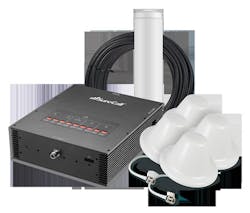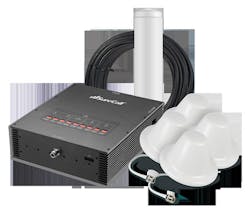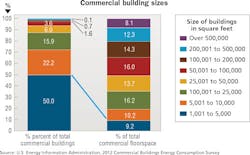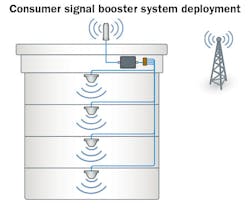Improving wireless coverage in smaller buildings
By Karl Griffith
Many times budget constraints prevent us from solving our client’s cellular reception problems. The installed cost of an active distributed antenna system (DAS) coupled with the lack of carrier funding is usually the issue. Active DAS solutions are better suited to serve large buildings and venues with large user counts. They are ideal for taking the load off of a cellular service provider’s macro network. A problem exists because active DAS solutions do not easily scale downward to satisfy the needs of smaller buildings, smaller spaces, and smaller user counts. Fortunately, there is a Federal Communications Commission (FCC) approved, passive DAS solution known as consumer signal booster that may fit the need of many smaller enterprises. The consumer signal booster is less expensive than an active DAS and consumer signal boosters also come in commercial versions that can be specified, designed, and installed by cabling contractors and integrators.
By definition a signal booster amplifies the wireless signal that is received from a donor antenna and distributes the amplified signal via coaxial cable to indoor antennas serving weak signal areas in a building. Other terms for these devices are repeaters, amplifiers, or passive DAS. Their use is limited to Cellular (Part 22), Broadband PCS (Part 24), AWS-1, 700-MHz Lower A-E Blocks, 700-MHz Upper C Block (Part 27) and Specialized Mobile Radio (Part 90).
This is different from an active DAS, which has centralized base station permitting (network aware) direct connections from multiple carriers each with their own input port. The input signals are combined, processed, and distributed typically with optical fiber to strategically placed powered remote units connected to the indoor antennas. The remote units eliminate cable attenuation regardless of the distance from the base station. These systems have extensive end-to-end monitoring and remote management. Design and installation is restricted to the wireless service provider’s licensees and their qualified installers.
Following are a few examples where smaller, scalable DAS solutions are needed.
- Smaller buildings constructed with materials such as steel, concrete, and low-energy glass hampering cellular reception
- Buildings in which cellular service is inadequate in part of the building, but not the entire building
- Leased space in a building and the building owner will not invest in a DAS solution for the tenants
- Large campuses with low signal strength in a few buildings but not all buildings
- Buildings in underserved rural areas
The need for robust cellular connectivity is more than a convenience. Dropped calls, reduced data rates and loss of service are all problems that must be addressed. Quality wireless service is a necessity. Forty-six percent of U.S. cell-phone users state they “couldn’t live without” their cell phone according to the Pew Research 2014 American Trends Panel survey. Every day, decisions are being made to move and relocate to satisfy the wireless connectivity needs of building owners, employees, tenants, and customers. Small and medium businesses have the same operational business needs as large enterprises.
The U.S. commercial building inventory is mostly smaller buildings. The U.S. Energy Administration 2012 Commercial Building Energy Consumption Survey indicates 88 percent of commercial buildings are 25,000 square feet or smaller. These buildings represent more than 35 percent of the total commercial floor space. Also noteworthy, commercial buildings constructed between 2000 and 2012 average 19,000 square feet. Obviously, there is a large service area/market requiring improved cellular coverage in this building category.
With the above understanding, as well as ensuring wireless networks are not adversely affected by signal boosters, the FCC developed the “Amendment of Parts 1, 2, 22, 24, 27, 90 and 95 of the Commission’s Rules to Improve Wireless Coverage Through the Use of Signal Boosters (WT Docket No. 10-4, Document No. FCC 13-21).” This “Report and Order” dated February 20, 2013 is the new federal regulatory requirement providing the technical, operational, and registration rules for low power signal boosters. All signal boosters sold and marketed after May 1, 2014 must comply. The “Report and Order” was developed with consensus of the major wireless service providers (carriers), industry associations, and manufacturers. Some of the participants in the process included the Association for Information Communications Technology Professionals (ACUTA), The Wireless Association (CTIA), The HetNet Forum (formerly The DAS Forum), The Wireless Infrastructure Association (CTIA), and The Telecommunications Industry Association (TIA).
Consumer signal boosters come in various designs to perform specific functions. These are: 1) mobile/vehicle, 2) home/personal workspace, 3) small and medium businesses (SMB), 4) commercial, 5) machine to machine (m2M).
Commercial use
Confusion may exist because of the FCC’s use of the term “consumer” in the document. Some may equate the word “consumer” with “residential.” This is not the case. The FCC rules do not have specific prohibitions restricting commercial use of consumer signal boosters to a specific building type. In fact, the document (Section 1, Paragraph 4) clearly states the FCC will conduct outreach to educate small business on the consumer signal booster regulatory framework. Manufacturers of consumer signal boosters have kitted solutions specifically designed for commercial use. The basic kits include a five-band signal booster unit designed for use with all major wireless service providers. The kits also include an outdoor (donor) omnidirectional antenna, an indoor antenna, and preconnectorized 50-ohm cables. Directional yagi donor antenna systems are also available.
Additional antennas, cables, and coupling components may be added to the consumer signal booster. These system-expansion accessories are also part of the manufacturer’s pre-engineered solution approved by the FCC. Unauthorized accessories are prohibited as they may alter the gain at the antenna and may increase the potential for interference. Technical resources are available from the manufacturers to assist with system expansion so adequate signal can be provided to underserved areas in a building. Iain Gillott, founder and president of iGR, a market research consultancy focused on the wireless and mobile industry, puts it this way: “Signal boosters are a valid and beneficial part of the het-net [heterogeneous network]. They provide a solution to a specific problem-how to cost-effectively extend coverage to outlying areas of a building.”
Consumer signal boosters designed for commercial use are ideal for cabling contractors. The installation can become extremely complex very quickly for end users. The commercial solution requires mounting an outdoor donor antenna on the roof or side of the building. A handheld RF signal strength meter is used to measure 4G LTE and 2G-3G PCS/cellular frequency signal strength. Data from the meter helps the contractor determine the best location and direction of the donor antenna.
The outdoor donor antenna cabling must be routed to the indoor signal booster location. Each indoor antenna requires a cable pathway, which may pass through risers, ceilings and plenum spaces. Power is also required near the signal booster. Clearly these installations require the services of structured cabling infrastructure professionals with commercial building experience. Manufacturers of commercial consumer signal boosters welcome trained and credentialed contractors to specify and install commercial consumer signal booster systems. As incentive, they are offering installer programs and training. Iain Gillott also states, “Enterprises have many options to providing wireless coverage in a building, including WiFi. Signal boosters have several benefits, especially that they can be installed without specific RF expertise and without the assistance of a mobile operator.”
FCC compliance requirements
These solutions are pre-engineered and are designed to operate “out of the box” without “fine tuning” or adjustments. They must comply with the FCC Network Protection Standard (NPS). The standard outlines the built-in technical safeguards to protect against network and adjacent channel interference, oscillation and cell site signal overload. Specifically, the standard requires the consumer signal boosters comply with the technical parameters of the spectrum band they operate in, self-monitor and automatically shut down if not in compliance with the standard. They are also required to automatically detect and correct oscillations that may occur in the uplink and downlink, and shut down when the signal booster is not needed. They must have interference avoidance features and the compliance features cannot be easily defeated. Consumer signal boosters must also be certified to ensure they meet the rules outlined in the FCC Report and Order. A list of all FCC-approved devices (so far) was published February 8, 2016 and is available on the FCC website.
All consumer signal boosters must be registered with the wireless service providers. This registration is also a “condition of authorization” or consent to operate the signal booster. Practically, this rule provides the wireless providers the ability to locate, notify the owner, and shut down a signal booster if it interferes with their network. Registration is an online process. Each wireless service provider has a website and procedure to facilitate the registration and offer consent to operate.
The consumer signal booster manufacturers must provide specific labeling indicating the installed device is a consumer device. The labeling must appear on the device, the packaging, the owner’s manual, installation instructions and marketing materials. Label language as specified by the FCC follows.
This is a CONSUMER device.
BEFORE USE, you MUST REGISTER THE DEVICE with your wireless provider and have your provider’s consent. Most wireless providers consent to the use of signal boosters. Some providers may not consent to the use of this device on their network. If you are unsure, contact your provider.
You MUST operate this device with approved antennas and cables as specified by the manufacturer. Antennas MUST be installed at least 20 cm (8 inches) from any person.
You MUST cease operating this device immediately if requested by the FCC or a licensed wireless service provider.
WARNING. E911 location information may not be provided or may be inaccurate for calls served by using this device.
The FCC Report and Order also provides information and guidance for industrial signal boosters. The category industrial signal booster represents all signal boosters other than consumer signal boosters. Industrial signal boosters are also passive DAS solutions. They are very similar to the consumer signal booster, except they have higher gain and output power and are more designed to serve larger buildings and venues with large user counts. Similar to active DAS solutions, their installation is restricted to the wireless licensees and their qualified installers. They may only be installed with “explicit” wireless licensee consent and close wireless service provider (carrier) coordination. These systems are widely deployed today.
Additional and more-detailed information is available from the following resources.
- FCC Report and Order (106 pages): fcc.gov/document/use-and-design-signal-boosters-report-and-order
- The FCC Signal Booster website: fcc.gov/wireless-telecommunications/signal-boosters/general/consumer-signal-boosters
- The list of approved Signal Boosters: https://apps.fcc.gov/edocs_public/attachmatch/DA-16-137A1_Rcd.pdf
- The FCC Electronic Comment Filing System, ECFS 3.0. Here you can find all the docketed proceedings including notices and comments for wireless signal boosters. fcc.gov/ecfs/search/filings?proceedings_name=10-4
Karl Griffith serves manufacturers, distributors, installers, and consumers in the communication connectivity supply chain through his company Karl Griffith Consulting, LLC. He retired in April 2016 after 39 years with Graybar Electric Company. He served his last 25 years at Graybar in corporate marketing as a product specialist, market manager, and director of emerging technology. He also served two terms on BICSI’s board of directors and holds the Registered Communications Distribution Designer (RCDD) credential. Griffith welcomes inquiries and comments at [email protected].




